AUDI Q7 2017 Owner´s Manual
Manufacturer: AUDI, Model Year: 2017, Model line: Q7, Model: AUDI Q7 2017Pages: 402, PDF Size: 100.39 MB
Page 341 of 402
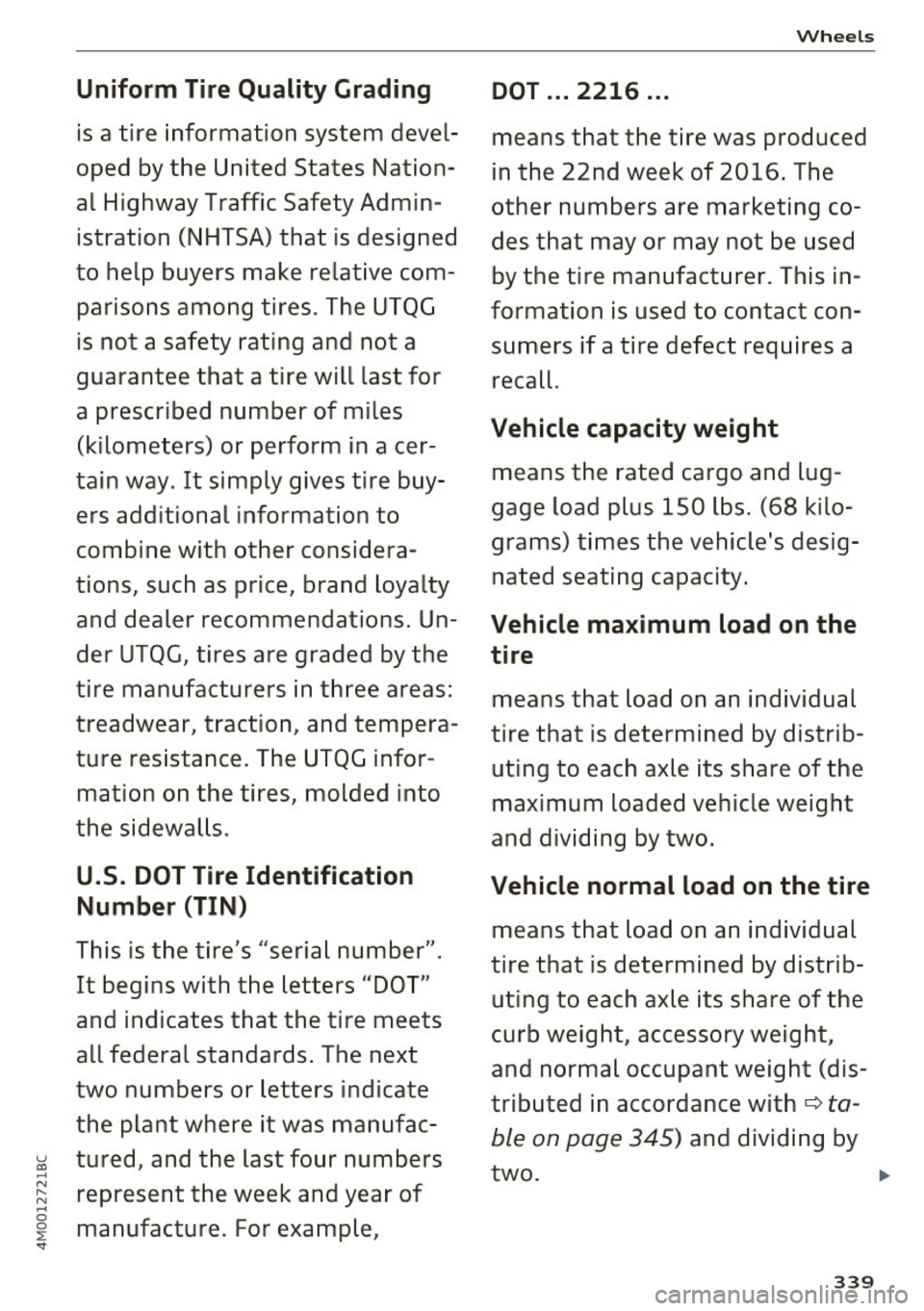
Uniform Tire Quality Grading
is a tire information system devel
oped by the United States Nation
al Highway Traffic Safety Admin
istration (NHTSA) that is designed
to help buyers make relat ive com
parisons among tires . The UTQG
is not a safety rating and not a
guarantee that a tire will last for
a prescribed number of mi les
(kilometers) or perform in acer
tain way. It simply gives t ire buy
e rs add itional informa tion to
combine with other considera
tions, such as p rice, brand loya lty
and dealer recommendations . Un
der UTQG, tires are graded by t he
tire manufacturers in th ree areas:
treadwear, traction, and tempera
ture res istance. The UTQG infor
mation on the tires, molded into
the s idewalls .
U.S. DOT Tire Identification
Number (TIN)
This is the tire's "serial number".
It beg ins with the le tters "DO T"
and indicates that the tire meets
all federal standards . T he nex t
two numbers or letters indicate
the plant where it was manufac -
~ tu red, and the last fo ur numbers ....
~ represent the week and yea r of ....
~ manufacture. For examp le, ...
Wheels
DOT ... 2216 ...
means that the tire was produced
in the 22nd week o f 2016 . The
other numbers are marketing co des that may or may not be used
by the t ire manufact urer. This in
formation is used to contact con sumers if a tire defec t req uires a
reca ll.
Vehicle capacity weight
means the rated cargo and lug
gage load plus lS0 lbs . (68 k ilo
grams) t imes the vehicle's desig
na ted seating capacity.
Vehicle maximum load on the
tire
means that load on an ind iv idual
tire tha t is determined by dist rib
ut ing to eac h ax le its share of the
maximum loaded vehic le weight
and dividing by two.
Vehicle normal load on the tire
means that load on a n individual
tire that is determined by dist rib
uting to each ax le its share of the
curb weight , accessory weight ,
and normal occupant weigh t (dis
tributed in accordance wit h
c:::> ta
ble on page 345) and dividing by
two. .,.
339
Page 342 of 402
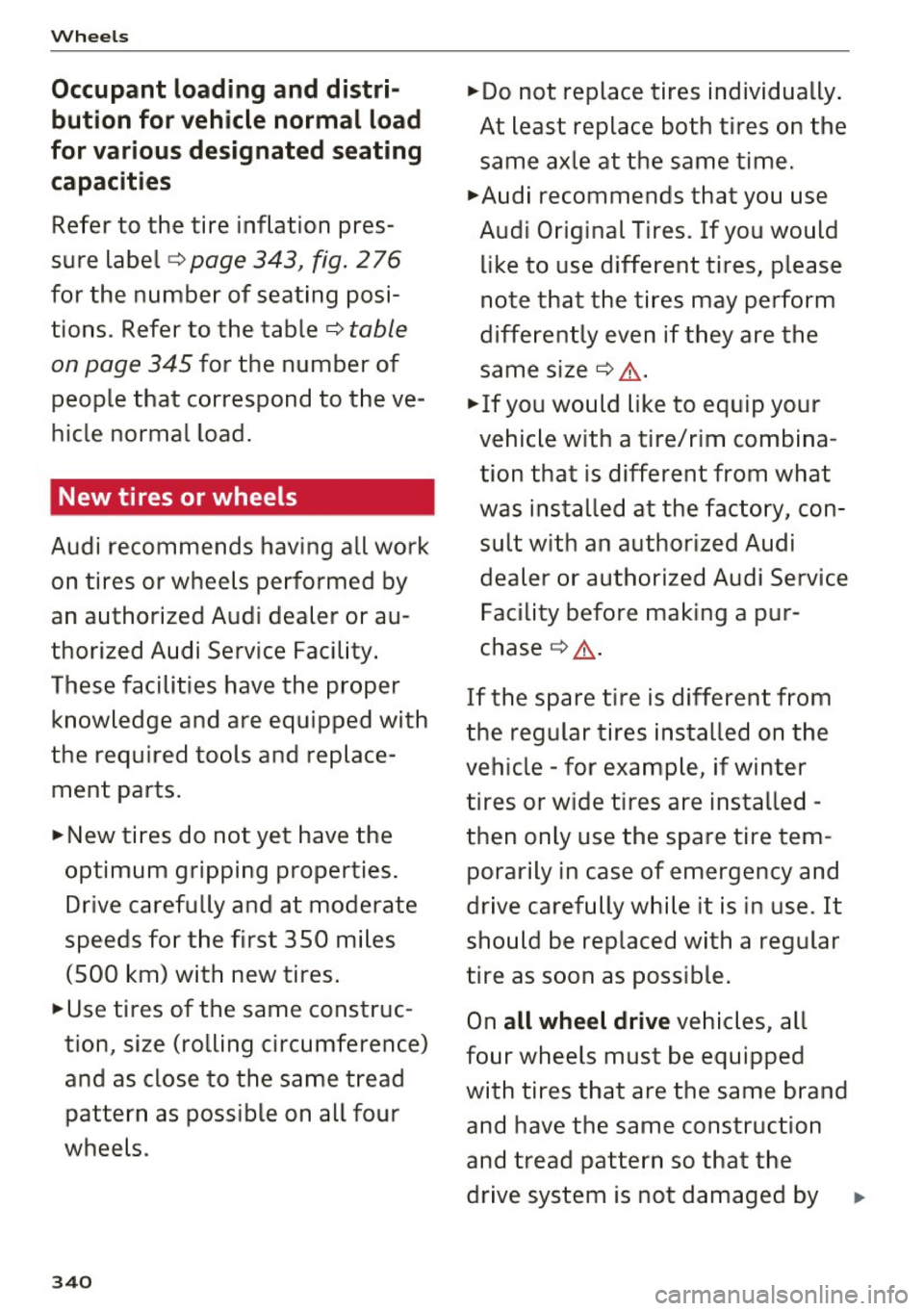
Wheel s
Occupant loading and distri
bution for vehicle normal load
for various designated seat ing
capacit ies
Refer to the tire inflation pres
sure label ¢
page 343, fig . 276
for the number of seating posi
tions . Refer to the table¢
table
on page 345
for the number of
people that correspond to the ve
hicle normal load .
New tires or wheels
Audi recommends having all work
on tires or wheels performed by
an authorized Audi dealer or au
thorized Audi Service Facility .
These facilities have the proper knowledge and are equipped with
the required tools and replace
ment parts.
.,. New tires do not yet have the
optimum gripping properties. Drive carefully and at moderate
speeds for the first 350 miles (500 km) with new tires .
.,. Use tires of the same construc
tion, size (rolling circumference)
and as close to the same tread pattern as poss ible on all four
wheels .
340
.,.Do not replace tires individually .
At least replace both tires on the
same axle at the same time.
.,. Audi recommends that you use
Audi Original Tires. If you would
like to use different tires, please
note that the tires may perform
differently even if they are the
same size ¢
,&..
.,. If you would like to equip your
vehicle with a tire/rim combina
tion that is different from what
was installed at the factory, con
sult with an authorized Audi
dealer or authorized Audi Service Facility before making a pur
chase ¢&, .
If the spare t ire is different from
the regular tires installed on the
vehicle -for example, if winter
tires or wide tires are installed -
then only use the spare tire tem
porarily in case of emergency and
drive carefully while it is in use. It
should be replaced with a regular
tire as soon as possible.
On
all wheel drive vehicles, all
four wheels must be equipped
with tires that are the same brand and have the same construction
and tread pattern so tha t the
drive system is not damaged by .,.
Page 343 of 402
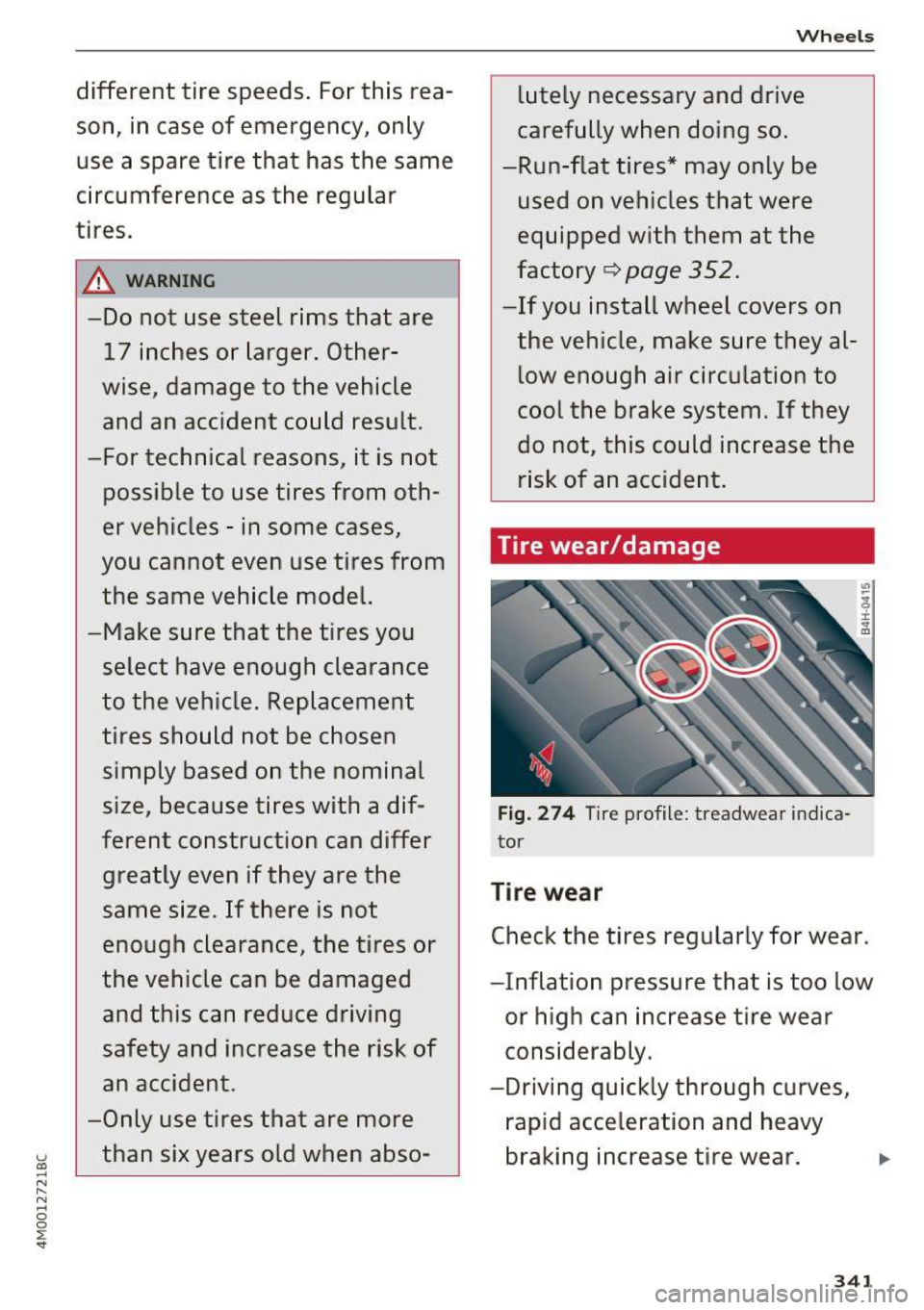
u a,
-N
" N .... 0
0
l: ..
different tire speeds. For this reason, in case of emergency, only
use a spare tire that has the same
circumference as the regular
tires.
&,_ WARNING
-Do not use steel rims that are 17 inches or larger. Other
wise, damage to the vehicle
and an accident could result.
-For technical reasons, it is not
possible to use tires from oth
er vehicles -in some cases,
you cannot even use tires from
the same vehicle model.
-Make sure that the tires you
select have enough clearance
to the vehicle. Replacement
tires should not be chosen
simply based on the nominal
size, because tires with a dif
ferent construction can differ greatly even if they are the
same size. If there is not
enough clearance, the tires or
the vehicle can be damaged
and this can reduce driving
safety and increase the risk of
an accident.
-Only use tires that are more
than six years old when abso-
Wheels
lutely necessary and drive
carefully when doing so.
-Run-flat tires* may only be used on vehicles that were
equipped with them at the
factory
¢ page 3 52.
-If you install wheel covers on
the vehicle, make sure they al low enough air circulation to
cool the brake system. If they
do not, this could increase the
risk of an accident.
Tire wear/damage
Fig. 274 T ire profile: treadwear indica
tor
Tire wear
Check the tires regularly for wear.
-Inflation pressure that is too low
or high can increase tire wear
considerably.
-Driving quickly through curves, rapid acceleration and heavy
braking increase tire wear.
341
Page 344 of 402
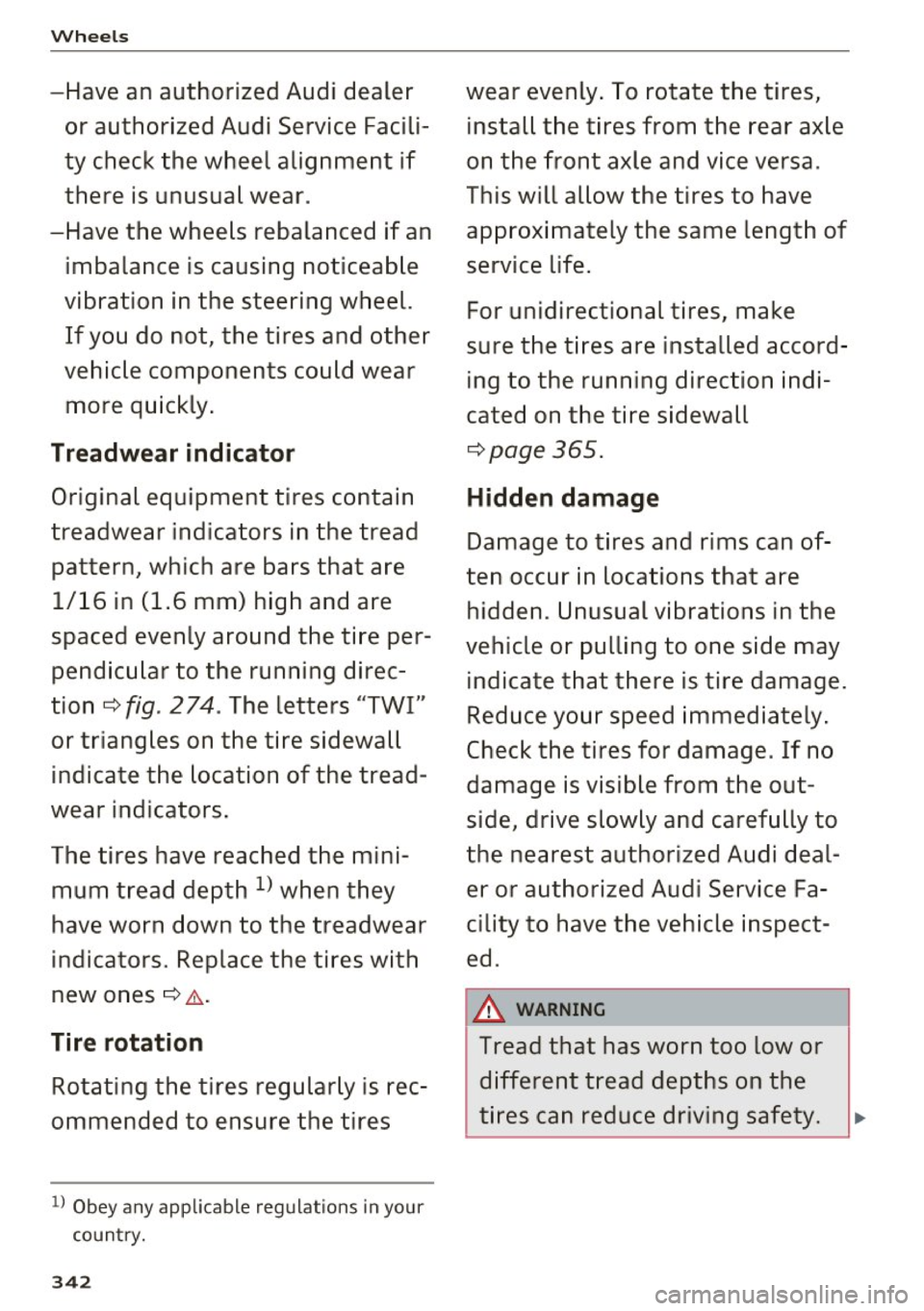
Wheels
-Have an authorized Audi dealer or authorized Audi Service Facili
ty check the wheel alignment if
there is unusual wear .
-Have the wheels rebalanced if an
imbalance is causing noticeable
vibration in the steering wheel. If you do not, the tires and other
vehicle components could wear more quickly.
Treadwear indicator
Original equipment tires contain
treadwear indicators in the tread
pattern, which are bars that are 1/16 in (1.6 mm) high and are
spaced evenly around the tire per pendicular to the running direc
tion¢
fig . 2 74 . The letters "TWI"
or triangles on the tire sidewall indicate the location of the tread
wear indicators .
The tires have reached the mini mum tread depth
l) when they
have worn down to the treadwear
indicators. Replace the tires with
new ones ¢
..&..
Tire rotation
Rotating the tires regularly is rec
ommended to ensure the tires
1> Obey any applicable regulations in your
country.
342
wear evenly. To rotate the tires,
install the tires from the rear axle
on the front axle and vice versa .
This will allow the tires to have
approximately the same length of
service life.
For unidirectional tires, make
sure the tires are installed accord
ing to the running direction indi
cated on the tire sidewall
¢page 365.
Hidden damage
Damage to tires and rims can of
ten occur in locations that are hidden . Unusual vibrations in the
vehicle or pulling to one side may indicate that there is tire damage.
Reduce your speed immediately.
Check the tires for damage. If no
damage is visible from the out
side, drive slowly and carefully to
the nearest authorized Audi deal
er or authorized Audi Service Fa
cility to have the vehicle inspect
ed .
.&_ WARNING
Tread that has worn too low or
different tread depths on the
tires can reduce driving safety. ,..
Page 345 of 402
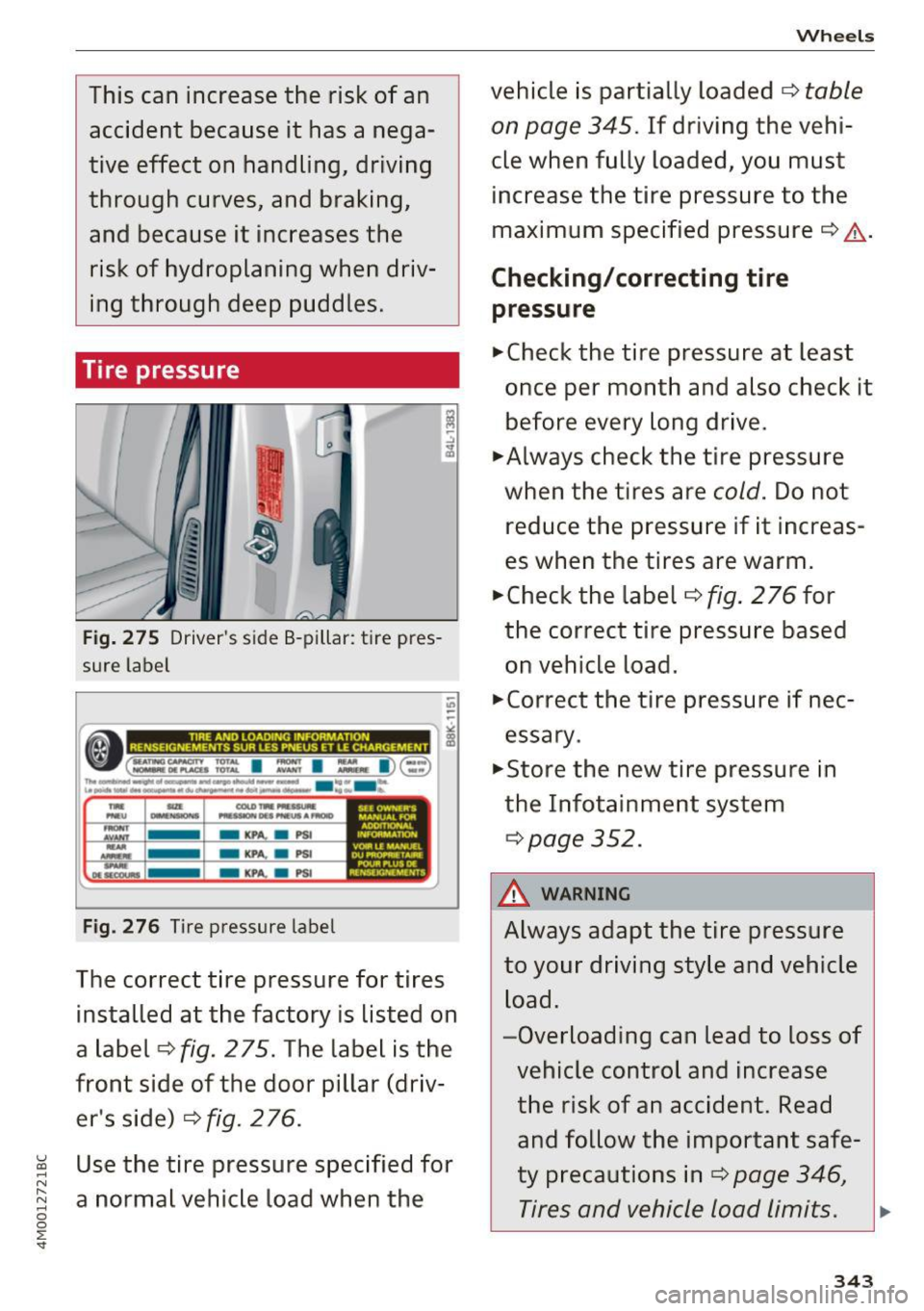
This can increase the risk of an accident because it has a nega
tive effect on handling, driving
through curves, and braking, and because it increases the risk of hydroplaning when driv
ing through deep puddles.
Tire pressure
I
4
0
Fig. 275 Driver's side B-pillar: tire pres
sure label
Fig. 276 Tire pressure label
The correct tire pressure for tires
installed at the factory is listed on
a label¢
fig. 2 75. The label is the
front side of the door pillar (driv er's side) ¢
fig. 2 76.
~ Use the tire pressure specified for
N
:::; a normal vehicle load when the .... 0 0 ~
vehicle is partially loaded¢ table
on page 345.
If driving the vehi
cle when fully loaded, you must
increase the tire pressure to the
maximum specified pressure¢&, .
Checking/correcting tire
pressure
.,.Check the tire pressure at least
once per month and also check it before every long drive.
.,.Always check the tire pressure
when the tires are
cold. Do not
reduce the pressure if it increas
es when the tires are warm .
.,.Check the label ¢
fig. 2 76 for
the correct tire pressure based
on vehicle load.
.,.Corre ct the tire pressure if nec
essary .
.,.Store the new tire pressure in
the Infotainment system
¢ page 352.
A WARNING
Always adapt the tire pressure
to your driving style and vehicle
load.
-Overloading can lead to loss of vehicle control and increase
the risk of an accident. Read and follow the important safe
ty precautions in¢
page 346,
Tires and vehicle load limits .
343
Page 346 of 402
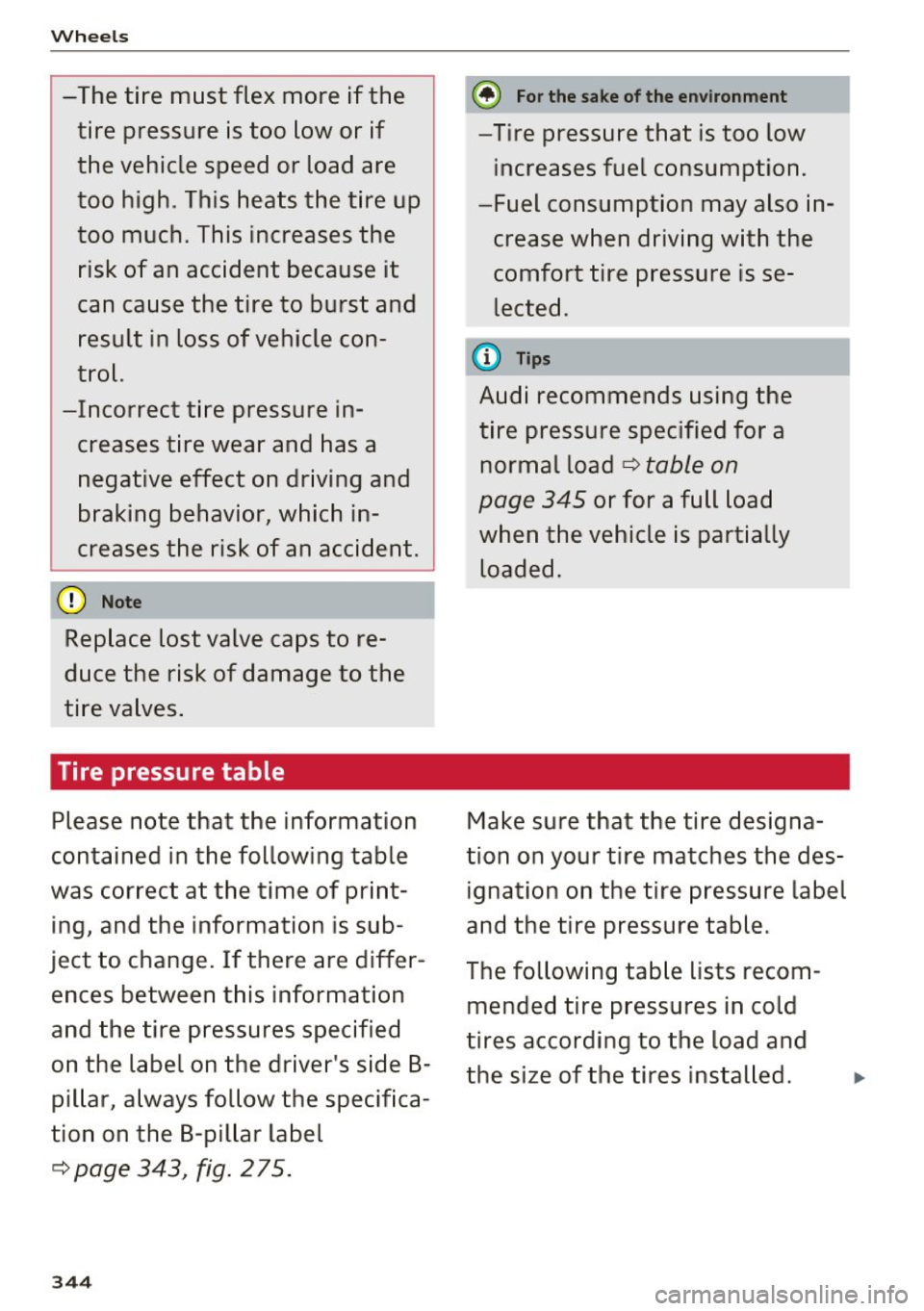
Wheels
-The tire must flex more if the tire pressure is too low or if
the vehicle speed or load are
too high . This heats the tire up
too much. This increases the
risk of an accident because it
can cause the tire to burst and
result in loss of vehicle con
trol.
-Incorrect tire pressure in creases tire wear and has a
negative effect on driving and
braking behavior, which in
creases the risk of an accident.
(D Note
Replace lost valve caps to re
duce the risk of damage to the
tire valves.
Tire pressure table
Please note that the information
contained in the following table
was correct at the time of print
ing, and the information is sub
ject to change. If there are differ
ences between this information
and the tire pressures specified
on the label on the driver's side 8-pillar, always follow the specifica
tion on the 8-pillar label
¢ page 343, fig. 275.
344
(i} For the sake of the environment
-Tire pressure that is too low
increases fuel consumption.
-Fuel consumption may also in
crease when driving with the
comfort tire pressure is se
lected .
(D Tips
Audi recommends using the
tire pressure specified for a
normal load
¢ table on
page 345
or for a full load
when the vehicle is partially loaded.
Make sure that the tire designa
tion on your tire matches the des ignation on the tire pressure label
and the tire pressure table.
The following table lists recom mended tire pressures in cold
tires according to the load and
the size of the tires installed.
Page 347 of 402
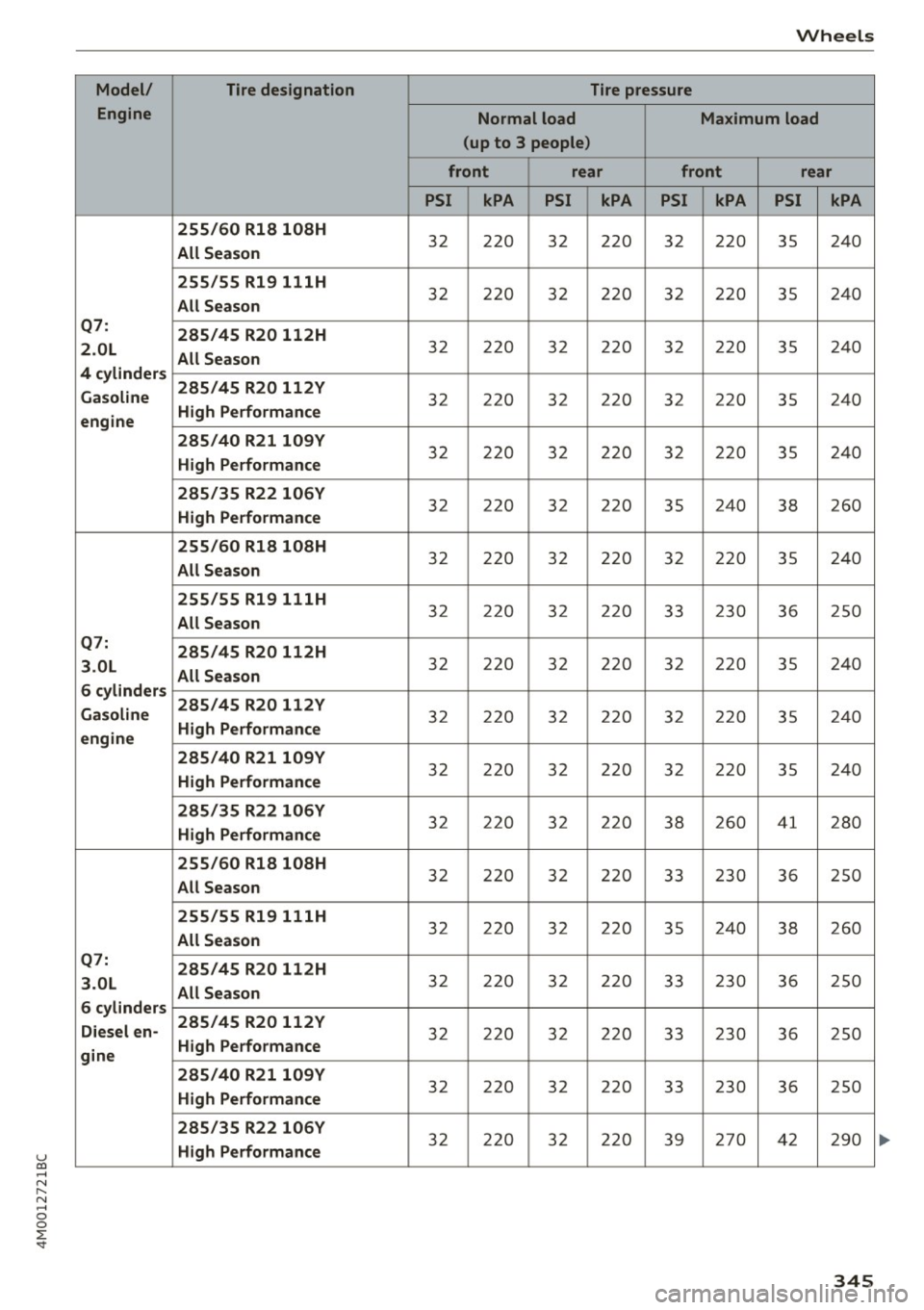
u co ...... N r-... N ...... 0
0
:E: '
Engine
Q7:
2.0L
4 cylinder s
Gasoline
engine
Q7:
3.0L
6 cylinder s
Gasoline
engine
Q7:
3.0L
6 cylinders
Diesel en-
gine Tire designation
255 /60 Rl8 108H
All Season
255 /55 Rl9 lllH
All Season
285/45 R20 112H
All Season
285 /45 R20 112V
High Performance
285 /40 R21109Y
High Performance
285/35 R22 106V
High Performance
255 /60 Rl8 108H
All Season
2 55 /55 Rl9 lllH
All Season
285 /45 R20 112H
All Season
285 /45 R20 11 2V
High Performance
285/40 R21109Y
High Performance
285 /35 R22 106V
High Performan ce
255/60 Rl8 108H
All Season
255/55 Rl9 lllH
All Season
285 /45 R20 112H
All Season
285/45 R20 112V
High Performance
285 /40 R21109Y
High Performance
285 /35 R22 106V
High Performance
Wheels
Tire pressure
Normal load
Maximum load
(up to 3 people )
front rear front rear
PSI kPA PSI kPA PSI kPA PSI kPA
32 220 32 220 32 220 35
240
32 220 32 220 3 2 220 35 2 40
32 220 32 220 3 2 220 35 24 0
32 220 32 220 32 220 35 240
3 2 2 20 3 2 220 3 2 220 35 24 0
32 220 32 220
35 240
38 260
32 220 32 220 32 220 35 240
3 2 220 32 220 33 230 36 250
32 220 32 220 32 220 35 240
32 220 32 220 3 2 220 35 240
32 220 32 220 32 220 35 2 40
32 220 32 220 38 260 41
280
3 2 220 32 220 33 23 0 36 2 50
32 220 32 220
35 240
38 260
32 220 32 220 33 230 36 250
3 2 22 0 32 220 33 230 36 250
32 220 32 220 33 230 36 250
3 2 220 3 2 220 39 270 42 290
345
Page 348 of 402
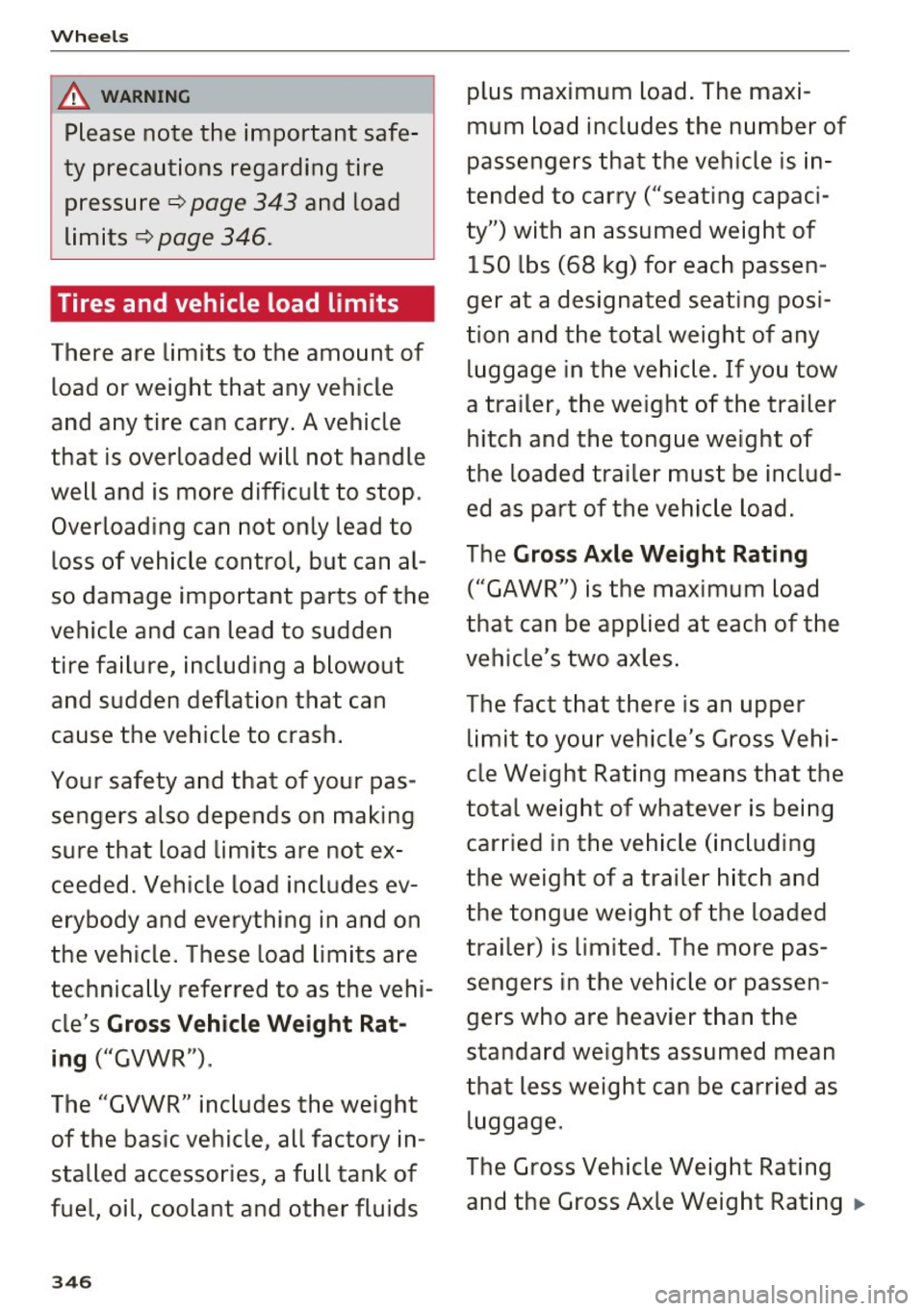
Wheels
&_ WARNING
Please note the important safe
ty precautions regarding tire
pressure¢
page 343 and load
limits¢
page 346.
Tires and vehicle load limits
There are limits to the amount of load or weight that any vehicle
and any tire can carry . A vehicle
that is overloaded will not handle
well and is more difficult to stop .
Overloading can not only lead to loss of vehicle control, but can al
so damage important parts of the
vehicle and can lead to sudden
tire failure, including a blowout
and sudden deflat ion that can
cause the vehicle to crash.
Your safety and that of your pas
sengers also depends on making
sure that load limits are not ex
ceeded. Vehicle load includes ev
erybody and everything in and on
the vehicle . These load limits a re
technically referred to as the vehi
cle's
Gross Vehicle Weight Rat
ing
("GVWR") .
The "GVWR" includes the weight of the basic vehicle, all factory in
stalled accessories, a full tan k of
fuel, oil, coolant and other fluids
3 4 6
plus maximum load. The maxi
mum load includes the number of
passengers that the veh icle is in
tended to carry ("seating capaci
ty") with an assumed weight o f
150 lbs (68 kg) for each passen
ger at a designated seat ing pos i
tion and the total weight of any luggage in the veh icle. If you tow
a trailer, the weight of the trailer
hitch and the tongue we ight of
the loaded trailer must be includ ed as part of the vehicle load.
The
Gross Axle Weight Rating
("GAWR") is the maximum load
that can be applied at each of the
vehicle's two axles .
The fact that there is an upper
limit to your vehicle's Gross Vehi
cle Weight Rating means that the
total weight of whatever is being
carried in the vehicle (inc luding
the weight of a trailer h itch and
the tongue weight of the loaded
trailer) is limited . The more pas
sengers in the vehicle or passen
gers who are heavier than the
standard weights assumed mean
that less weight can be carried as luggage .
The Gross Vehicle Weight Rating and the Gross Axle Weight Rat ing .,.
Page 349 of 402
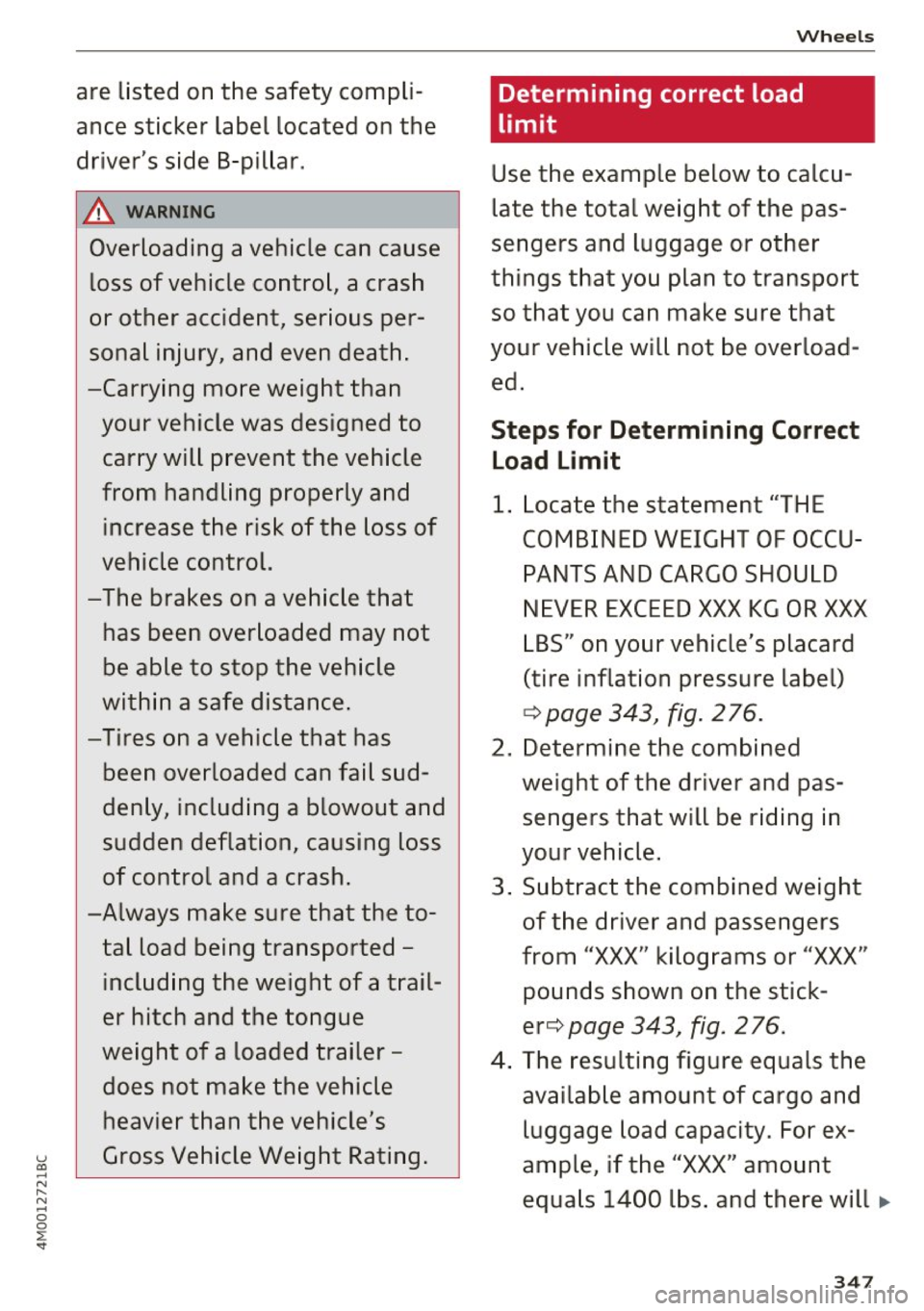
u
"' ... N
" N ... 0
~ ...
are listed on the safety compli
ance sticker label located on the
driver's side 8-pillar.
.&_ WARNING
Overloading a vehicle can cause loss of vehicle control, a crash
or other accident, serious per
sonal injury, and even death.
-Carrying more weight than
your vehicle was designed to carry will prevent the vehicle
from handling properly and increase the risk of the loss of
vehicle control.
-The brakes on a vehicle that
has been overloaded may not
be able to stop the vehicle
within a safe distance.
-Tires on a vehicle that has
been overloaded can fail sud
denly, including a blowout and
sudden deflation, causing loss
of control and a crash.
-Always make sure that the to
tal load being transported - incl uding the weight of a trail
er hitch and the tongue
weight of a loaded trailer -
does not make the vehicle heavier than the vehicle's
Gross Vehicle Weight Rating.
Wheels
Determining correct load
limit
Use the example below to calcu
late the total weight of the pas
sengers and luggage or other
things that you plan to transport
so that you can make sure that
your vehicle will not be overload
ed.
Steps for Determining Correct Load Limit
1. Locate the statement "THE
COMBINED WEIGHT OF OCCU
PANTS AND CARGO SHOULD
NEVER EXCEED XXX KG OR XXX
LBS" on your vehicle's placard
(tire inflation pressure label)
¢ page 343, fig. 2 76.
2. Determine the combined
weight of the driver and pas
sengers that will be riding in
your vehicle.
3. Subtract the combined weight of the driver and passengers
from
"XXX" kilograms or "XXX"
pounds shown on the stick
er ¢
page 343, fig. 2 76.
4. The resulting figure equals the
available amount of cargo and
luggage load capacity. For ex
ample, if the
"XXX" amount
equals 1400 lbs. and there will.,,.
347
Page 350 of 402

Wheels
be five 1 SO lb s. pa ssengers in
y our vehicle, th e amou nt of
av ail abl e c arg o and lu gga ge
lo ad ca pac ity is 650 lb s.
(1400- 750 (5 X 150) = 650
lb s.)
5 . De termin e the combined
w eight of lu gg ag e and cargo
bein g loade d on the vehi cle .
Th at w eight may not sa fel y ex
c e ed t he a vail able car go and
lugg age l oa d ca paci ty ca lc ulat
ed in St ep 4 .
6 . If yo ur ve hicle will b e towing a
tr aile r, lo ad from your tr aile r
will b e tran sfe rr ed to your v e
hi cle. C onsul t t his manual t o
dete rmin e how this re du ces
th e av ail ab le c argo and lug
g age load capa cit y of y our vehi
cl e.
~ c hec k th e tire sidewall
(¢ pa ge 333, fig. 2 73) to de ter
min e the de sign ated load rating
for a specific tire.
Wheel bolts and rims
Wheel bolts
Wheel bolts must be clean and loosen/t ighten
easi ly .
Rims
Rims with a bolted rim ring* or w ith bolted whee l
covers* consist of mu ltiple pieces . These compo
nents we re bolted together using special bolts
348
and a spec ia l proced ure. Yo u must no t repair or
disassemb le them
c:::> .&. .
A WARNING
Wheel bo lts that are tightened or repaired in
correct ly can become loose and resu lt in loss
of vehicle contro l, wh ich increases the risk of
an accident. For the correct tighten ing spec ifi
cation, see
c:::> page 365, Finishing.
- Always keep the wheel bolts and the
threads in the wheel h ub clean and free of
grease .
- Only use wheel bolts that fit the rim.
- Always have damaged rims repaired by an
author ized Audi dealer or authorized Audi
Serv ice Facility . Never repa ir or disassemb le
rims yourself, because this increases the risk
of an accident.
Winter tires
Winter tires significant ly improve the vehicle's
hand ling when dr iv ing in winter conditions. Be
cause of their construct ion (w idth, compound,
tread pattern), summer tires provide less t rac
tion on ice and snow .
.,. Use win ter tires on all four wheels.
.,. On ly use winter tires that a re approved for your
veh icle.
.,. Please note that the maximum permitted
speed may be lower with winter tires
c::> &_ . An
authorized Audi dealer or authorized Audi Serv
ice Facility can inform you about the maximum
permitted speed for your tires .
.,. Check the tire p ressure after installing wheels
c::> page 343 .
The effectiveness of winter tires is reduced great
ly when the tread is worn down to a depth of
0 .16 in (4 mm). The cha racteristics of winte r
t ir es a lso decrease g reatly as the t ire ages , re
gard less of the rema ining t read.
.&_ WARNING
-
- Never d rive fas ter than the max imum pe r
mitted speed for your tires . This could cause
the tires to heat up too much . This increases
~